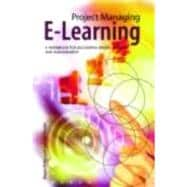
Note: Supplemental materials are not guaranteed with Rental or Used book purchases.
Purchase Benefits
Looking to rent a book? Rent Project Managing E-Learning: A Handbook for Successful Design, Delivery and Management [ISBN: 9780415772204] for the semester, quarter, and short term or search our site for other textbooks by McVay Lynch; Maggie. Renting a textbook can save you up to 90% from the cost of buying.
| â¼" SET UPForward â¼" Why we wrote this book. How to use this book | |
| Philosophy and Principles | |
| Definition and Goals of E-Learning and Its Environment | |
| content dissemination vs. collaborative learning- mobile computing | |
| Why E-learning Needs Project Management- 25? | |
| Top 10? reasons E-Learning Projects Fail- 25? | |
| Top 10? reasons E-Learning Projects Succeed- consistency of product and process | |
| Typical E-learning Development Lifecycle without Project Management- request for course- assignment to department/division- either work with SME or put existing content on the web as is- course taught- revisions made | |
| Brief Overview of Project Management Core Processes | |
| Initiate- Plan- Execute- Control and monitor- Close | |
| Blending Project Management Principles with E-Learning Goals | |
| Why formalize an organic process? | |
| â¼" Core Processes | |
| Initiating- Needs Analysis and Defining and E-Learning Problem | |
| Survey data- Using focus groups | |
| Analyzing changing requirements- Defining Quality | |
| Selecting an E-Learning Project- Identifying stakeholders | |
| Gaining Sponsors- Develop Project Charter | |
| The project charter authorizes the project- Purpose and Goals- Brainstorming- Scope- Develop Preliminary Project Scope Statement | |
| Preliminary project scope statement is a high-level definition of the project | |
| Planning- Project Management Plan | |
| A substantial document with tabs or sections dedicated to the subplans below | |
| Staffing Plan- Communication Plan- Quality Plan- Training Plan | |
| Risk Management Plan- Resource Acquisition Plan | |
| Requirements development (project definition) | |
| Functional and Technical Requirements | |
| Brainstorming instructional strategies | |
| Determining hardware/software needs | |
| Developing the blueprint | |
| Work Breakdown Structure | |
| Break the project output into deliverables (e.g., e-learning course prototype, e-learning course, participant documentation/help files, intallation/implementation documentation) | |
| Activity definition/activity duration estimation | |
| Activity sequencing (which comes first) | |
| Project Estimating- Consulting time- Development time (and what to do when time is too long) | |
| Needed resources (and what to do when resources are not avail) | |
| Costing models (and what to do when it costs too much) | |
| Delivery cycle planning- Determining Milestones/Timeline and deliverables | |
| Usability study/pilot | |
| Cycle Review Sessions- Picking the Right Things To Measure | |
| Formative vs. summative evaluations of process/product | |
| Long-term vs. short term | |
| Critical success factors | |
| Business productivity- Scope Planning | |
| Needs Analysis and Defining an E-Learning Problem | |
| Survey data- Using focus groups | |
| Analyzing changing requirements | |
| Defining quality | |
| Selecting an E-Learning Project | |
| Identifying stakeholders | |
| Gaining sponsor(s) | |
| Holding the project kickoff meeting | |
| Determining Team Configurations | |
| Internal vs external (or both) teams | |
| The job of a project manager | |
| Role definition (go over what the "job" is of each possible role: SME, ID, media spec. programmer, etc.) | |
| Executing- Configuration management | |
| Building the infrastructure- content management systems- standards compliance- course management systems | |
| Component integration- Vendor/contractor selection and contracting | |
| Prototyping (creating draft materials) | |
| Course templates | |
| Activity templates | |
| Pedagogical considerations | |
| Producing master materials | |
| Role re-definition (how roles change as project matures) | |
| Revision tracking/feedback- Testing | |
| Delivering the final product/system | |
| Deployment (reproduction and distribution) | |
| Training product delivery staff (faculty, trainers, managers) | |
| Building momentum for release | |
| Monitoring and Control | |
| Scope verification/control | |
| Scope creep- Feature creep | |
| Requirements management | |
| Measuring quality | |
| Tracking progress | |
| Collaboration vs | |
| Control- Managing client/stakeholder''s expectations | |
| Formative Evaluation and Evolutionary Design | |
| Monitoring and Evaluating/Re-evaluating Risks | |
| Quality Control- copyrig | |
| Table of Contents provided by Publisher. All Rights Reserved. |
The New copy of this book will include any supplemental materials advertised. Please check the title of the book to determine if it should include any access cards, study guides, lab manuals, CDs, etc.
The Used, Rental and eBook copies of this book are not guaranteed to include any supplemental materials. Typically, only the book itself is included. This is true even if the title states it includes any access cards, study guides, lab manuals, CDs, etc.